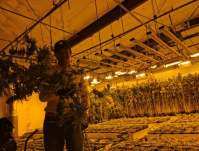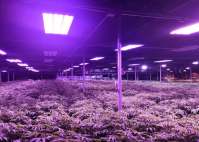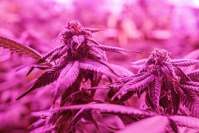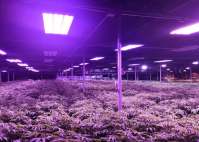What are the main parameters for the spectral parameterization of LED grow light:
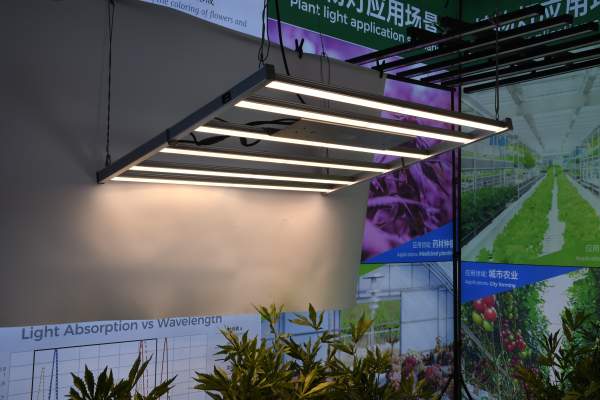
1. Radiant power
The radiant power of the LED lamp bead is the main indicator that determines the performance of the LED grow light. The radiant power is closely related to the PPF value of the lamp bead. The performance of the LED grow light is closely related. The radiation power is also related to the chip area. The larger the chip area, the higher the radiation power. The radiated power also affects the price, and the size of the radiated power is proportional to the price.
2. Power consumption
LED light beads are divided into power levels according to current specifications. The larger the current specification, the higher the power the chip can withstand, but the greater the heat generation of the chip. Chips with different current specifications are packaged into different sizes.
3. Radiation efficiency
The radiation efficiency of the lamp beads = radiation power / power consumption * 100%, the radiation efficiency value is less than 100%. The radiation efficiency expresses the proportion of the radiation power generated by each watt of electricity consumed. The larger the radiation efficiency, the better.
4. PPF value
The PPF of the lamp bead needs special software to calculate. The power of the LED grow light is calculated based on the PPF value. Without the PPF value, the LED grow light is not qualified.
5. MPF value
The measured value of photon flux with a wavelength in the range of 380nm-800nm, in umol/s.
6. QE value
The QE value is the PPF value per watt. It is a parameter derived from the spectral parameters of the grow light lamp beads. The unit is umol/J. The accuracy of the QE value relates to the spectral test technology level of the lamp beads, and measurement errors will cause the QE value to be distorted.
7. Radiation ratio
In the definition of the relationship between the radiation in the range of the waveband, radiation content: a certain waveband accounts for the percentage of the total radiation, and the radiation content is the weight of the radiation in a certain waveband to the total radiation. Radiation ratio: the ratio between the two bands, the radiation ratio is the unit weight between each other, usually R: B and R: FR.
8. Partial pressure specifications
It is the voltage division of the chip and the light sources connected in series and parallel, so that the current distribution of each string of light sources is uniform, which is beneficial to improve the life of the light source.
9. Light quality ratio parameters
The following lists the proportions of some plants:
(1) Lettuce: The light sources of red and blue light 6:1 and 7:1 respectively for planting and seedling cultivation are the most suitable for its growth.
(2) Leek: The ratio of plant height, stem thickness, leaf width and other mass ratios of leeks under the red/blue 7:1 treatment was significantly higher than other treatments.
(3) Cucumber: 7:2 is the best ratio of red and blue light for the growth of cucumber seedlings. And the growth period of 7:1 is the best ratio of red and blue light.
(4) Strawberry, tomato: red and blue light 9:1 is good for full fruit and rich nutrition.
(5) Holly: Red and blue light are arranged according to the ratio of 8:1. Holly grows best, is strong and has a very developed root system.
(6) White radish: the most suitable light quality for growth: the ratio of red and blue is 8:1.
(7) Sprouts: The effect is the most obvious with the ratio of red, green and blue light of 6:2:1.
(8) Green vegetables and water spinach: 7:1 is the best ratio of red and blue light for the growth of green vegetables and water spinach leaves.
(9) Calla lily: For growth conditions, the ratio of 6:2 between red and blue light is the best.
(10) Lettuce: The ratio of red and blue light is 9:1, which is beneficial to the growth of lettuce.
(11) Anthurium andraeanum scorching sun: Comprehensive analysis, 7:3 red and blue light treatment is better, which is conducive to morphology, root growth and dry matter accumulation.
(12) Dendrobium officinale: Red and blue light 7:3, the proliferation effect is the best; at 6:4, it is more conducive to photosynthesis and material accumulation of seedlings.
There is a tailor-made LED light light supplement light program for each growth period of each plant, but the data is not perfect. And the parameters can only be used as a partial reference. Whether it is the research of various countries in the world, or the major plant breeding and planting companies or the LED grow light plant lighting service provider, the parameters in this area are still under study, and the specific application needs to introduce the local at that time Other factors are considered comprehensively, so it is necessary to answer exactly which plant is suitable for which configuration.
At present, everyone refers to the data based on the ratio of sunlight spectrum, and adjusts flexibly according to the field planting situation and crop types and functions. The ratio of red to blue light of the sun is about 6-8:1. People refer to this to conclude that flower foliage or leaf viewing For vegetable-like plants, the configuration should be less than 6-8:1, so that the blue light is a little bit more, and the blue light has a promoting effect on the growth of plant leaves. For flower viewing, choose 6-8:1 or more for supplementary light during the flowering period, so that there will be more red light. Red light has a significant effect on the flowering and fruiting of plants. For other growth stages, follow the sunlight reference ratio, and choose 6-7:1.
The same plant has different requirements for light quality and light quantity in different growth periods. The cheaper LED light light can be used in the seedling period of the plant. LED light light bar is a good choice, and high-power plants can also be appropriately reduced. When the number of lights is on, the high-power LED light lights will be used when the plants bloom and bear fruit, so that the crops will grow at a very fast growth rate and produce excellent quality.
The spectrum can be customized according to different cultivated crops. By changing the photoperiod and LED spectrum, the effect of regulating plant nutrition, accumulating fruit expansion, and prolonging flowering period can be achieved; secondly, the photosynthetic rate of plants can also be changed by adjusting the light quantum flux density of LED lamps μmol/m2·s, thereby To control its growth rate to improve crop quality and yield.


